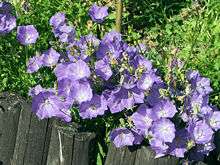Campanula carpatica
| Campanula carpatica | |
|---|---|
 | |
| Scientific classification | |
| Kingdom: | Plantae |
| (unranked): | Angiosperms |
| (unranked): | Eudicots |
| (unranked): | Asterids |
| Order: | Asterales |
| Family: | Campanulaceae |
| Genus: | Campanula |
| Species: | C. carpatica |
| Binomial name | |
| Campanula carpatica Jacq. | |
Campanula carpatica, the tussock bellflower[1][2] or Carpathian harebell, is a species of flowering plant in the family Campanulaceae, native to the Carpathian Mountains of Central Europe. It is a low-growing herbaceous perennial, with long stems bearing solitary blue bell-shaped flowers. It was introduced to the Royal Botanic Garden at Kew in 1774 by Nikolaus Joseph von Jacquin.[3] Several cultivars in shades of white, blue, pink and purple, have been developed for garden use.[4]
This plant has gained the Royal Horticultural Society's Award of Garden Merit.[5]
References
- ↑ "BSBI List 2007". Botanical Society of Britain and Ireland. Archived from the original (xls) on 2015-01-25. Retrieved 2014-10-17.
- ↑ "Campanula carpatica". Natural Resources Conservation Service PLANTS Database. USDA. Retrieved 10 January 2016.
- ↑ William Curtis (1790). "The Botanical Magazine": 117.
- ↑ RHS A-Z encyclopedia of garden plants. United Kingdom: Dorling Kindersley. 2008. p. 1136. ISBN 1405332964.
- ↑ "RHS Plant Selector - Campanula carpatica". Retrieved 21 June 2013.
| Wikimedia Commons has media related to Carpathian harebell (Campanula carpatica). |
This article is issued from
Wikipedia.
The text is licensed under Creative Commons - Attribution - Sharealike.
Additional terms may apply for the media files.